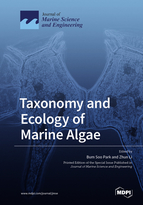Taxonomy and Ecology of Marine Algae
A special issue of Journal of Marine Science and Engineering (ISSN 2077-1312). This special issue belongs to the section "Marine Biology".
Deadline for manuscript submissions: closed (15 October 2021) | Viewed by 42906
Special Issue Editors
Interests: phytoplankton; microbial ecology; molecular ecology
Special Issues, Collections and Topics in MDPI journals
Interests: microbial diversity; microalgae; HABs; photosynthetic organisms; molecular ecology
Special Issues, Collections and Topics in MDPI journals
Special Issue Information
Dear Colleagues,
This Special Issue focuses on the taxonomy and ecology of marine algae. Recent findings indicate that marine environments have rapidly changed due to global warming over the past several decades. This change leads to significant variations in marine algal ecology. For example, a long-term increase in ocean temperatures due to global warming has facilitated the intensification of harmful algal blooms, which adversely impact public health, aquatic organisms, and aquaculture industries. Thus, extensive studies have been conducted, but there is still a knowledge gap in our understanding of the variation of their ecology in accordance with future marine environmental changes. To fill this gap, studies on the taxonomy and ecology of marine algae are highly necessary.
We invite researchers to submit research articles that enable us to advance our understanding of the taxonomy and ecology of marine algae. The scope of this Special Issue covers all aspects of the taxonomy and ecology of marine algae.
Dr. Bum Soo Park
Dr. Zhun Li
Guest Editors
Manuscript Submission Information
Manuscripts should be submitted online at www.mdpi.com by registering and logging in to this website. Once you are registered, click here to go to the submission form. Manuscripts can be submitted until the deadline. All submissions that pass pre-check are peer-reviewed. Accepted papers will be published continuously in the journal (as soon as accepted) and will be listed together on the special issue website. Research articles, review articles as well as short communications are invited. For planned papers, a title and short abstract (about 100 words) can be sent to the Editorial Office for announcement on this website.
Submitted manuscripts should not have been published previously, nor be under consideration for publication elsewhere (except conference proceedings papers). All manuscripts are thoroughly refereed through a single-blind peer-review process. A guide for authors and other relevant information for submission of manuscripts is available on the Instructions for Authors page. Journal of Marine Science and Engineering is an international peer-reviewed open access monthly journal published by MDPI.
Please visit the Instructions for Authors page before submitting a manuscript. The Article Processing Charge (APC) for publication in this open access journal is 2600 CHF (Swiss Francs). Submitted papers should be well formatted and use good English. Authors may use MDPI's English editing service prior to publication or during author revisions.
Keywords
- Taxonomy of marine algae
- Life cycle of marine algae
- Ecology of marine algae
- Harmful algal blooms
- Mechanism of algal blooms
- Algal microbiome
- Interaction between phytoplankton and bacteria
- Algal cultivation and production
- Algal parasites







